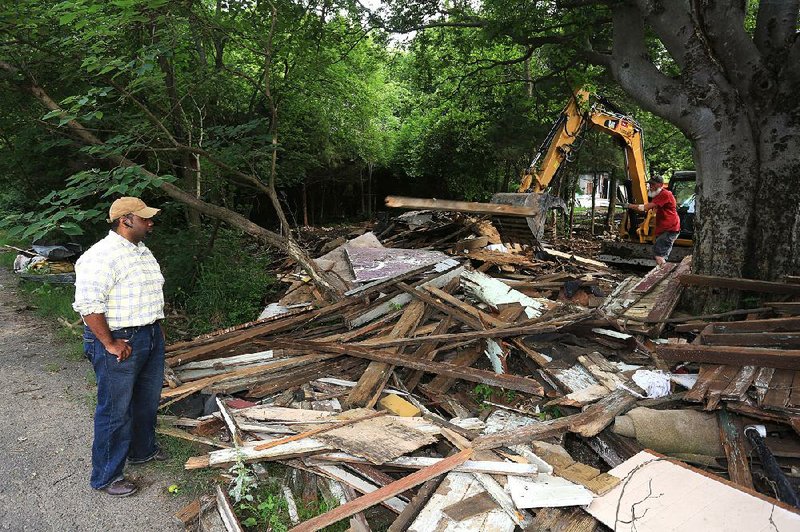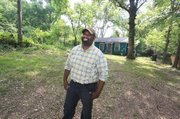Developer Jarrod Woodley has acquired 32 properties within the Capitol View historic neighborhood uphill from the state Capitol and said he will offer them for bid to builders interested in helping redevelop the area. Many of the lots he bought held ramshackle dwellings once occupied by vagrants and declared unsafe by the city.
Woodley razed most of those vacant buildings and reclaimed the materials for use by builders in other Little Rock neighborhoods.
Capitol View is generally considered to be an area bordered by West Markham Street on the north, Schiller Street and Riverview Drive on the east, West Seventh Street on the south, and Woodrow Street on the west. A small portion of Capitol View extends north of West Markham on the area’s east side.
The majority of the neighborhood is designated as a historic district on the National Register of Historic Places.
Woodley closed on his purchases in the second quarter of last year, and cleanup should wrap up this week. He maintained only three houses as rental properties. All his Capitol View properties are on South Park, Schiller, South Schiller, West Third and West Fourth streets. In addition to being offered to developers, they will be listed through real estate agents.
Real estate broker Tony Curtis, Woodley’s agent, said the lots will be offered for about $15,000 each with a discount for a developer who would want to buy all the properties. Pricing is difficult because there are few, if any, residential lots available or recently sold in the immediate area, Woodley said. The closest comparable sales are in the Quapaw Quarter.
Woodley said he paid roughly $150,000 for the 32 parcels.
“I’d like to get a group of builders that really subscribe to the idea of urban infill,” Woodley said. “We want to keep [future development] within the aesthetic of the neighborhood.”
He called the real estate offering a “builders draw,” a process by which builders can purchase property in an open and fair process. Builders will make bids on a given day and place, and when Woodley settles on a bid, the builders will have 30 days in which to close on the property.
Builder Bill Forbess recently built two houses in the extreme northeastern edge of Capitol View, in the 300 block of North Summit Street. One house sold and the other is still on the market. He still has three more lots on the street.
“I think that whole neighborhood is really ready for a renovation phase,” Forbess said. Many of the houses in the neighborhood were built as 1,100- to 1,200-square-foot homes that could easily be updated and expanded to 1,500 to 1,600 square feet “without spending a great amount of money.”
The architectural style in Capitol View is predominantly craftsman bungalow, which became the “cottage” at the turn of the 20th century, according to a detailed account and summation of the neighborhood written in 2008 by Sandra Taylor Smith and Anne Wagner Speed. The most prolific time of growth for Capitol View took place in the 1920s and ’30s.
Although there are many different types of bungalows within the historic district, “a common theme in their design links them,” Smith and Speed wrote. Bungalows are set low to the ground and have low-pitched roofs and wide eaves.
“It nestles into and becomes part of its environment,” they said. It was also common to use rustic materials for the homes’ exteriors.
Woodley’s first rehabilitation project, completed in 2011, was a dilapidated duplex he bought at 212 Barton St. and turned into a 2,000-squarefoot, single-family gem.
“I’m invested in this neighborhood,” he said while riding by his first project. He said he will let builders “cherrypick” from the available lots and will likely build on the leftovers.
“Realistically, you could just about build whatever you want over here, but if you were smart and want to have the good will of the neighborhood, I would suggest keeping it as period-relevant as possible,” the developer said. He’s prepared to provide building plans for prospective buyers/builders.
Sophie Mitchell, treasurer of the Capitol View-Stifft Station Neighborhood Association, said Woodley has attended several of the group’s meetings and has done a good job of keeping residents apprised of his intentions.
Three clusters of three lots each could be used to build up to 17 multifamily units on each cluster.
“I know that the sense is that whatever goes in there needs to be consistent with the historical makeup of the neighborhood — not an end to single-family residences,” Mitchell said.
“When you see somebody come in and buy a lot of properties up, I think people are a little nervous about what’s going to happen with the makeup of the neighborhood,” she said.
“We can advise, we can back a project … when they’re seeking permits and zoning and things like that we can oppose it at the city level, but even in the historic area I don’t think we have control because we don’t have rules or can dictate what goes on in the neighborhood,” Mitchell added.
Woodley also is a partner and developer in the yet unfinished Main Street Lofts downtown.


